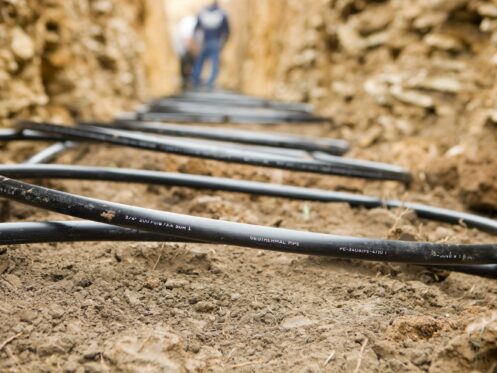Investing in a high-efficiency HVAC system is one of the most effective ways that you can reduce your long-term energy expenses. These systems use less energy while delivering consistent comfort throughout the house. High-efficiency models operate with advanced technology that maximizes performance and minimizes waste. Over time, this translates into significant savings on monthly utility bills. It also means you’ll need fewer repairs because the equipment is brand-new.
You will also have access to incentives like rebates and tax credits — all while reducing your impact on the environment. In this guide, we are going to look at some tips to make your HVAC system more efficient and save you money.
A Properly Sized HVAC System
Ensuring your HVAC system is the right size for your home plays a major role in energy efficiency and, consequently, the long-term costs of heating and cooling your home. A system that’s too small for your living space will run constantly. When it does this, it struggles to meet temperature demands, driving energy bills up even higher.
On the other hand, a system that is too large for your living space will cycle on and off frequently. This leads to uneven temperatures, wasted energy, and unnecessary wear and tear on the parts of the system. A correctly sized HVAC system runs more efficiently and maintains consistent indoor comfort. This reduces the risk of premature breakdowns, helping you save more on utility costs and repairs.
When the time comes for furnace or AC replacement, your HVAC service provider will make a precise calculation based on several factors that determine the right-sized system for you. This is a rough guide to the size of HVAC system you’re likely to need for your home:
- Homes between 600 and 900 square feet will need a 1.5-ton HVAC system.
- Homes between 900 and 1200 square feet will need a 2-ton HVAC system.
- Homes between 1200 and 1500 square feet will need a 2.5-ton HVAC system.
Well-Designed Ductwork
When your ductwork is sealed correctly, less air will be lost through leakage. When there are leaks in the system, the air that was already heated or cooled to your desired temperature escapes through the cracks and reduces efficiency. Poor ductwork creates inconsistent temperatures throughout your living space, placing an additional strain on your HVAC system. A well-designed system eliminates this issue and maintains a consistent temperature in your home by balancing the air.
Professional Installation: Key for High Efficiency
When you have one of our certified technicians handle the installation process, you will find that we know exactly where to place everything in your home. A proper setup ensures the system performs at its highest efficiency, which reduces energy waste and helps you save money. The size of the system and its duct configuration will be correct. We will also charge the refrigerant to ensure that the right amount is in the system.
Thermostat calibration will be another priority, allowing you to maintain comfortable levels without wasting energy. Performing all these steps during installation will optimize airflow, which is also crucial for peak efficiency.
Sizing, Capacity, and Efficency
When seeking a higher level of efficiency in your home, consider the ratings assigned to heating and cooling units to gauge their capabilities. HVAC systems come with several key ratings that help measure their efficiency, performance, and environmental impact.
BTU Ratings
A British Thermal Unit (BTU) rating indicates the amount of heat that an HVAC system can remove from your living space in an hour. Make sure that the BTUs on the unit match the size of your home. For example, a 6,000 to 8,000 BTU air conditioner will suffice for a single room, but if you aim to cool your entire living space, you will need an AC with a rating of at least 24,000 BTUs.
SEER and SEER2 Ratings
Seasonal Energy Efficiency Ratio (SEER) measures the cooling efficiency of air conditioners and heat pumps over an entire cooling season. A higher SEER rating indicates that the system is more energy efficient. Systems with a SEER rating of 16 or higher are highly efficient and lead to significant energy savings.
On Jan. 1, 2023, the SEER system was updated to SEER2 with new regulations and more realistic and accurate testing procedures. With a new SEER2-certified HVAC system, you can receive rebates and incentives for upgrading a more efficient model that has a lower environmental impact.
HSPF Ratings
A Heating Seasonal Performance Factor (HSPF) rating measures the heating efficiency of air-source heat pumps. Similar to the SEER ratings, a higher HSPF rating indicates a more efficient system. In the United States, a highly efficient system has an HSPF rating of 9 or higher.
Savings Based on Efficiency: High vs. Low
When you upgrade to a high-efficiency model, you can enjoy significant savings. To start, a highly efficient model uses less energy to heat and cool your living space. With good SEER2 and HSPF ratings, you can reduce energy usage by up to 40%. Imagine that your energy bill is $150 a month; upgrading to a more efficient model could reduce your monthly cost to $90. While the initial cost may be higher, you will save thousands over the unit’s lifespan by having lower energy bills. Rebates and incentives are available to help offset the initial cost. There are also fewer maintenance needs for a newer model.
Efficient Geothermal Options
When considering an upgrade to your HVAC system, a geothermal option, such as using a heat pump to heat and cool your living space, is the most efficient method. Geothermal systems use the stable temperature of the earth to heat and cool your home, which requires far less energy than conventional systems.
In fact, they can be up to 400% more efficient. Even though the initial cost of installation is higher, you can save significantly on operating costs. This means that during the winter, savings can add up to about 70%, and during the summer, you can easily save as much as 50%.
Geothermal HVAC systems are a smart investment in comfort, efficiency, and sustainability. With long-term cost savings and environmental benefits, they are an excellent choice if you are looking to reduce your energy footprint and utility expenses. The installation process will be longer for a geothermal system; however, it will deliver even heating and cooling throughout your entire living space.
Since these models are more durable, the lifespan tends to be much longer. In fact, the ground loop can last up to 50 years, with internal components lasting up to 25 years, so you will not need a replacement anytime soon.
Contact a Dependable HVAC Company Today
At Kalins Indoor Comfort, we know that saving money is a priority when looking to upgrade your HVAC system. With over 100 years of experience, our family-owned business puts your comfort and your needs above all else. You can trust us to install an efficient geothermal system to save you money over time.
When your system needs repairs, we will provide repair and maintenance services to improve its efficiency. Our motto is, “When you want comfort …You want Kalins!”
For all your HVAC needs, contact Kalins Indoor Comfort to schedule an appointment!











